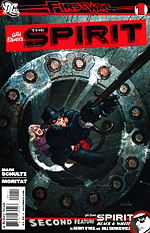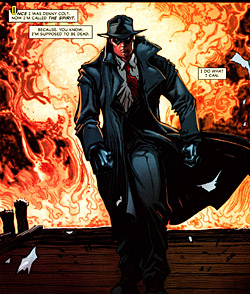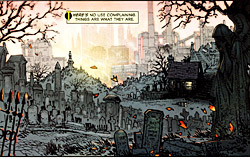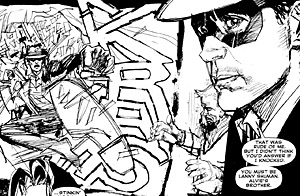 Written by Mark Schultz and Denny O’Neil
Written by Mark Schultz and Denny O’Neil
Art by Moritat and Bill Sienkiewicz
40 pages, color, with some black and white
Published by DC Comics
As part of DC Comics’s new First Wave group of pulp hero comics, we’re getting another attempt from DC to use Will Eisner’s crime-fighting character, the Spirit. While I’m still not entirely convinced that crushing all these characters into a single "world" is a great idea, another The Spirit comic seems to make sense. After all, DC was already publishing The Spirit, so giving it an additional brand to draw attention to the title seemed reasonable. Now that I’ve read the first issue, though, I’m not so sure my gut instinct was correct on this one.
 Mark Schultz is writing the first three issues of The Spirit, casting Denny Colt as a hard-edged, grim crime fighter. While I don’t claim to be an expert on Will Eisner’s original comics (I’ve probably read no more than 20% of the original run), the one thing that immediately struck me was that this is no more Will Eisner’s The Spirit than the film directed by Frank Miller was. In fact, I’d go so far as to say that this version of The Spirit seems to draw directly from the film rather than the original comics. Considering that the film was a critical and commercial failure, I’m mystified as to why this is a good idea. The Spirit stalking away from buildings while they explode into flames behind him? I can’t imagine any fan of The Spirit comics up until now (not only Eisner’s, but also more recent takes like Darwyn Cooke or Sergio Aragones’s versions) thinking, "Yeah, this is what the character is all about." Maybe I’m wrong, perhaps The Spirit when I wasn’t reading it included main villains who were known for terrorist tactics and torture, but right now I’m just not buying it.
Mark Schultz is writing the first three issues of The Spirit, casting Denny Colt as a hard-edged, grim crime fighter. While I don’t claim to be an expert on Will Eisner’s original comics (I’ve probably read no more than 20% of the original run), the one thing that immediately struck me was that this is no more Will Eisner’s The Spirit than the film directed by Frank Miller was. In fact, I’d go so far as to say that this version of The Spirit seems to draw directly from the film rather than the original comics. Considering that the film was a critical and commercial failure, I’m mystified as to why this is a good idea. The Spirit stalking away from buildings while they explode into flames behind him? I can’t imagine any fan of The Spirit comics up until now (not only Eisner’s, but also more recent takes like Darwyn Cooke or Sergio Aragones’s versions) thinking, "Yeah, this is what the character is all about." Maybe I’m wrong, perhaps The Spirit when I wasn’t reading it included main villains who were known for terrorist tactics and torture, but right now I’m just not buying it.
 The sad thing is that the art in The Spirit #1 is gorgeous; Moritat has created a lush if slightly dark version of Central City, with everything from oil rigs to graveyards drawn in loving detail. He’s got a sharp, angular style to his art, something I don’t normally associate with the character, but it works here. The Spirit leaps and moves across the book with grace, and that’s something that feels just like how Eisner did it all of those years. And, as I said before, I do like his dark version of Central City, if only because of his execution with all of the little details. With clotheslines stretched across buildings and gleaming neon signs at night, it’s a great look for the setting.
The sad thing is that the art in The Spirit #1 is gorgeous; Moritat has created a lush if slightly dark version of Central City, with everything from oil rigs to graveyards drawn in loving detail. He’s got a sharp, angular style to his art, something I don’t normally associate with the character, but it works here. The Spirit leaps and moves across the book with grace, and that’s something that feels just like how Eisner did it all of those years. And, as I said before, I do like his dark version of Central City, if only because of his execution with all of the little details. With clotheslines stretched across buildings and gleaming neon signs at night, it’s a great look for the setting.
 There’s also a back-up black and white story by Denny O’Neil and Bill Sienkiewicz, and while I hate to say that the attraction is once again the art, that’s absolutely the case. O’Neil’s story is a bit unremarkable, just another typical crime story that happens to star the Spirit. Sienkiewicz’s art, though, looks dynamite, After getting used to his excellent inks on Tom Denerick over on The Web, it’s made me start hoping for a full piece of art from Sienkiewicz and he doesn’t disappoint here. Sienkiewicz is the kind of artist that you either love or hate, but there’s no doubt in my mind that his art is to love. I love how what could look like a random scrawl of lines instead perfectly coalesces into a perfectly drawn figure, or how he repeats a piece of paper twisting and turning in the air as it falls so that it’s a series of overlapping drawings that beautifully mimics the real thing. Even his gloomy opening six panels that show off a variety of objects that also spell out "Spirit" is a real treat; it’s fantastic seeing these pages, a real reminder of how much I’ve loved his art over the years.
There’s also a back-up black and white story by Denny O’Neil and Bill Sienkiewicz, and while I hate to say that the attraction is once again the art, that’s absolutely the case. O’Neil’s story is a bit unremarkable, just another typical crime story that happens to star the Spirit. Sienkiewicz’s art, though, looks dynamite, After getting used to his excellent inks on Tom Denerick over on The Web, it’s made me start hoping for a full piece of art from Sienkiewicz and he doesn’t disappoint here. Sienkiewicz is the kind of artist that you either love or hate, but there’s no doubt in my mind that his art is to love. I love how what could look like a random scrawl of lines instead perfectly coalesces into a perfectly drawn figure, or how he repeats a piece of paper twisting and turning in the air as it falls so that it’s a series of overlapping drawings that beautifully mimics the real thing. Even his gloomy opening six panels that show off a variety of objects that also spell out "Spirit" is a real treat; it’s fantastic seeing these pages, a real reminder of how much I’ve loved his art over the years.
I’m not entirely sure if Schultz is merely the first in a series of writers on the book or not, but DC has already announced a new writer as of The Spirit #4. I’m hoping this means they’ve changed their mind on the direction and tone for The Spirit, because right now this feels like it’s turning to exactly the wrong influence to draw in readers. I want to like The Spirit, but if this is the best that DC can do right now, I’d almost rather just go without.
